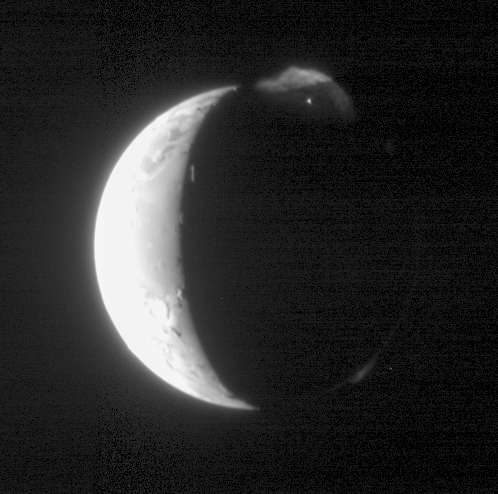
Credit: NASA/Johns Hopkins University Applied
Physics Laboratory/Southwest Research Institute
NASA recently published a stunning view of Jupiter's volcanic moon Io,
acquired by the Pluto-bound New Horizons spacecraft, during its recent
rendezvous with Jupiter. The image shows a gigantic volcanic plume ejected
during the ongoing eruption of the Ionian volcano Tvashtar.
The plume is over 300 km high. It is illuminated by direct sunlight, and
sunlight reflected off Jupiter.
The day-side of Io is overexposed in this relatively long exposure to bring
out the faint details in the plume's complex structure.
The image was obtained applying the Long Range Reconnaissance Imager
(LORRI) device aboard New Horizons, 19 hours after arrival at Jupiter on 28
February 2007. The spacecraft was 2.3 million km from Io.
The sunlit plume faintly illuminates the surface below it. "New
Horizons and Io continue to astonish us with these unprecedented views of the
solar system's most geologically active body," said John Spencer, deputy
leader of the New Horizons Jupiter Encounter Science Team, and an Io expert
from Southwest Research Institute.
Like our Moon, Io keeps one side turned to its parent planet. As this image
shows the far side of Io that faces away from Jupiter, the giant planet only
illuminates a slender crescent of Io's night-side, highlighting the edge of the
disk at lower right. Another plume, believed to be emanating from the volcano Masubi,
is illuminated by Jupiter just above this lower right edge.
A faint plume, barely visible at the 2 o'clock position, could be the first
plume observed from the volcano Zal Patera.
As in other New Horizons images of Io, mountains reflect light from the
setting Sun just beyond the terminator (the line between the day and night
sides). The most prominent, visible as a bright vertical line, is the edge of a
plateau about 4.5 km high, similar in height to the Colorado Rockies.
Image processing has been applied to reduce high contrast in the original
data.
Io is the innermost of the Galilean moons. It is the fourth largest moon in
the Solar System. With a diameter of 3,630 km, Io is somewhat larger than our Moon (3,476 km across). It also orbits its parent planet at a similar distance of
about 400,000 km.
Due to Jupiter's strong gravity, which is 250% greater than that of Earth,
Io orbits Jupiter in only 1.7 days. (Jupiter is approximately 320 times more
massive than Earth.)
Further reading
A Midnight Plume
http://pluto.jhuapl.edu/gallery/missionPhotos/pages/031307.html
New Horizons Mission Homepage
http://pluto.jhuapl.edu/index.php
Aymen Mohamed Ibrahem